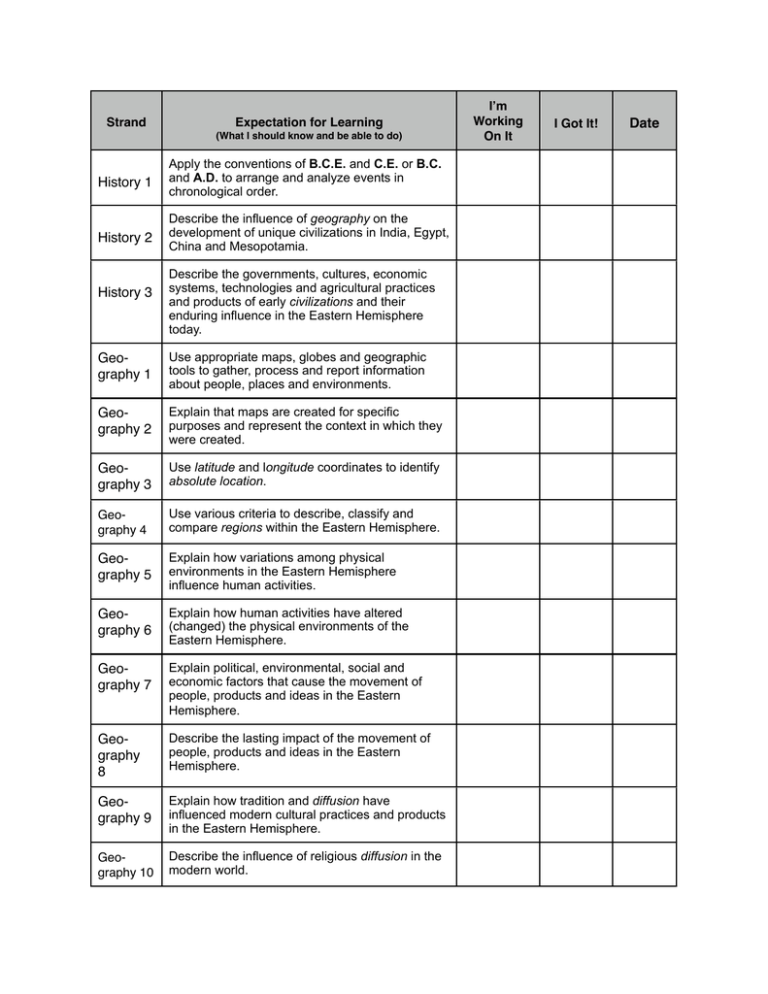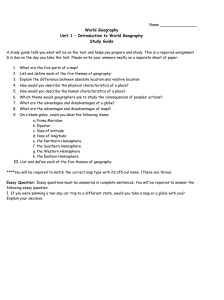Date History 1 History 2
advertisement

Strand Expectation for Learning (What I should know and be able to do) History 1 Apply the conventions of B.C.E. and C.E. or B.C. and A.D. to arrange and analyze events in chronological order. History 2 Describe the influence of geography on the development of unique civilizations in India, Egypt, China and Mesopotamia. History 3 Describe the governments, cultures, economic systems, technologies and agricultural practices and products of early civilizations and their enduring influence in the Eastern Hemisphere today. Geography 1 Use appropriate maps, globes and geographic tools to gather, process and report information about people, places and environments. Geography 2 Explain that maps are created for specific purposes and represent the context in which they were created. Geography 3 Use latitude and longitude coordinates to identify absolute location. Geography 4 Use various criteria to describe, classify and compare regions within the Eastern Hemisphere. Geography 5 Explain how variations among physical environments in the Eastern Hemisphere influence human activities. Geography 6 Explain how human activities have altered (changed) the physical environments of the Eastern Hemisphere. Geography 7 Explain political, environmental, social and economic factors that cause the movement of people, products and ideas in the Eastern Hemisphere. Geography 8 Describe the lasting impact of the movement of people, products and ideas in the Eastern Hemisphere. Geography 9 Explain how tradition and diffusion have influenced modern cultural practices and products in the Eastern Hemisphere. Geography 10 Describe the influence of religious diffusion in the modern world. I’m Working On It I Got It! Date Strand Expectation for Learning (What I should know and be able to do) Geography 11 Use a variety of historic and contemporary sources to obtain multiple perspectives on a topic. Geography 12 Examine a variety of sources for accuracy. Govt. 1 Govt. 2 Describe the relationship between those in power and individual citizens in a democracy, dictatorship, monarchy and theocracy. Explain that the characteristics of government can often overlap and that the categorization of governments can misrepresent the actual relationship between those governing and those being governed. Econ 1 Compare economic data sets to identify relationships and draw conclusions. Econ 2 Predict the present and future consequences of an economic decision and explain how individuals and societies may evaluate the choice differently. Econ 3 Explain how individuals and societies answer the fundamental questions of economics. Econ 4 Explain how specialization leads to global trade. Econ 5 Explain how supply, demand and competition interact to determine price. Econ 6 Explain how supply, demand and competition interact to influence quantities of inputs and outputs Econ 7 Explain how individuals compare price and quality when selecting goods and services to buy. I’m Working On It I Got It! Date





